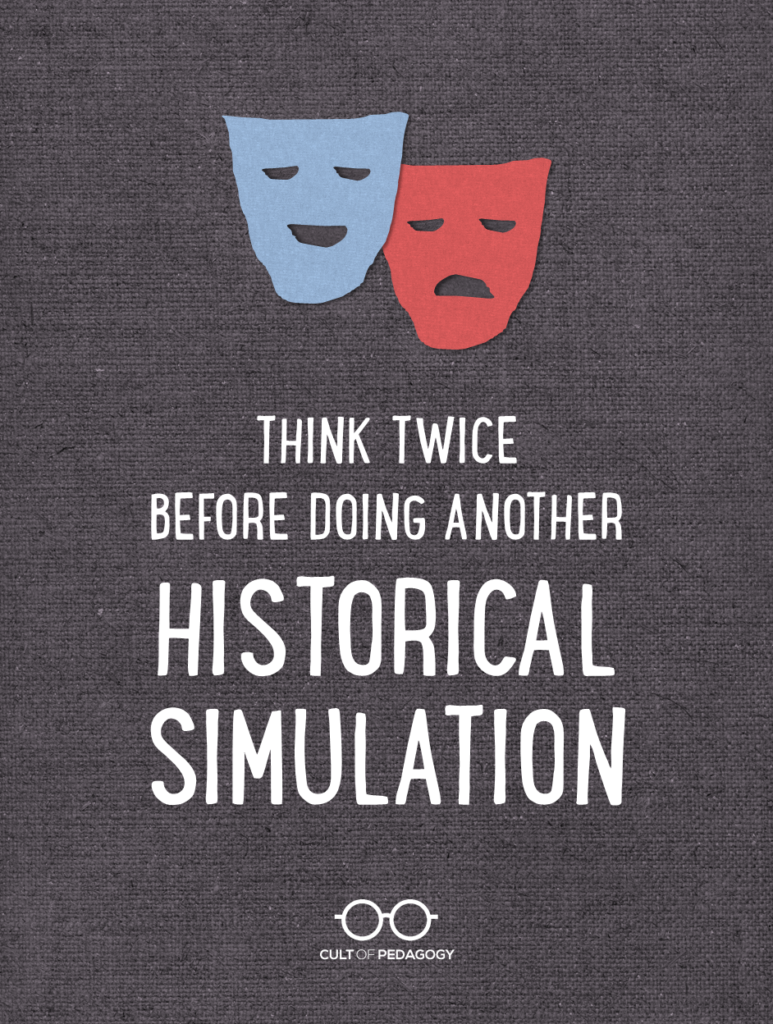
Listen to my interview with Hasan Kwame Jeffries (transcript):
Sponsored by ProWritingAid* and Chill Expeditions
*Cult of Pedagogy is an affiliate for ProWritingAid. If you sign up for a paid account through the provided link, Cult of Pedagogy gets a small percentage of the sale at no extra cost to you.
What better way is there to learn about something than to actually live it? That’s the thinking behind classroom simulations, where teachers attempt to re-create an event and have students act as participants. Once they’ve walked in the shoes of the people who are actually part of a given situation, students should, in theory, reach new levels of understanding about that situation.
And for many academic topics, this holds true. Students will understand our legal system better if they participate in a mock trial. They’ll gain a deeper appreciation for what led to the Boston Tea Party after playing out the roles of colonists being taxed. Virtual simulations offer even more possibilities: A digital chemistry lab, for example, will allow students to mix many more chemicals and see their results far more easily than if they tried to gather and mix the same chemicals in real life.
But when it comes to certain events—those related to slavery, the holocaust, war crimes, or any other event where people experienced violence or trauma—simulations can do more harm than good. Although teachers who conduct these activities do so because they want students to develop deeper empathy for the people involved, they end up putting students in a position to inflict pain on each other and experience real trauma, all without much educational benefit at all.
We can do better.
To learn more about this issue, I talked with Hasan Kwame Jeffries, history professor and host of the Teaching Hard History podcast. In our conversation, we discussed why certain historical simulations are harmful, why teachers should stop doing them, and what they should be doing instead to teach those challenging topics well.

What is a classroom simulation?
“A simulation is basically an attempt to re-create a situation or a phenomenon from the past,” Jeffries explains, “to put students in a re-created environment as much as possible so that they can generate a stronger sense of empathy, particularly for those who suffered as a result of this historical situation or phenomenon.”
When they are designed well, simulations allow students to gain a deeper understanding of a particular situation, like this one about farming in the Gilded Age.
“Teachers are gravitating to simulations out of a desire to be better,” Jeffries says, “to think creatively and get students engaged in the classroom.”
Unfortunately, those good intentions don’t always get the desired results.
How Can Some Simulations Harm Students?
Problems with classroom simulations arise when teachers attempt to simulate traumatic experiences.
One example is the New York classroom where African American students were asked to play the role of enslaved people in a mock slave auction. Other simulations ask students to lie side by side on the floor to simulate the horrific Middle Passage across the Atlantic.
How do these experiences cause problems?
“Part of the problem with trying to simulate any traumatic experience is that you can’t actually recreate it,” Jeffries explains. “You can’t really simulate what it would feel like to be dehumanized on an auction block and separated from your parents. What you would need to do to actually re-create these scenarios would put you in jail.”
“So then what are you left with?” he continues. “You’re left with not only the potential for traumatizing children, but you’re reinforcing contemporary inequality: We cannot divorce the present from the past. We still live in a white supremacist world, and children are bringing that in. We don’t talk about racism and white supremacy and inequality in our society for the most part. But then we’re going to create this one-off classroom situation in which we’re going to sell black kids. What it does is create confusion on the parts of both students of color and white students. It can reinforce stereotypes rather than disrupting them. And especially when you begin to isolate children of color in these scenarios, it can really create a traumatic experience because you’re putting these children in what can be intense, sort of under-the-microscope conditions in which they are being treated as unequal. And then what are you doing to repair the damage after that?”
Some teachers might wonder if this problem can be solved by randomly assigning roles so that a student of any ethnicity might play the role of an enslaved person or a slave owner, or even deliberately reversing roles, having white students act as the enslaved people in the simulations.
Jeffries says no. “Essentially you would be telling these other children, okay, you’re going to be the black people for today, right? That doesn’t really help, because they can just walk in it, and then they walk out of it. And then how do they carry that into the playground? It’s like, okay, I had my black experience, and that is about being sold. In other words, even pretending that we’re going to do something that is race-neutral around a subject that is not race-neutral doesn’t really help the scenario either.”
Another problem with these types of simulations is that they run the risk of treating the subject matter too lightly, of trivializing it. When students are put in uncomfortable situations, they might laugh or goof around in response to that discomfort. “That’s a response to being insecure in the moment,” Jeffries says. “And that can have this sort of ripple effect that then trivializes a subject that you do not want to trivialize.”
He also warns that some online experiences can have a similar effect. “We have to be careful of the gamification of history. One of the most common online simulations is about enslaved people running away. I actually like the idea of having students think about the tough choices and decisions that it would take for somebody to escape slavery, but you have to create the right scenario for students to understand what the issues are. You can’t just have the character suddenly just wake up one morning and say, okay, do I leave or do I stay?”
To be worthwhile, an online simulation will have to provide more complicated, nuanced situations. “What are the consequences? What are the costs? Who’s being left behind?” Jeffries says. “There are so many other permutations that have to be included. And if they are not included, then I think you wind up going back to trivializing this history. If they’re not getting a full sense of the scope, of the conditions and circumstances, and the reasons why people would decide to escape and stay, then you’re actually doing a disservice. They’re learning less than what they should be learning.”
What Should Teachers Do Instead?
Rather than try to re-create these traumatic experiences, Jeffries recommends a more thoughtful, discussion-based approach, where teachers use literature or other texts to learn about particular phenomena, then ask students to think about and discuss the decisions people made in those circumstances.
“You don’t say, hey, what would you do if you were this person? You say, what did this person do? And what were some of their options? And so you’re inviting children on their own terms to put themselves in the shoes of another person simply by thinking about the decisions that they have in their lives.”
And these kinds of conversations should be happening all year, not just as part of an isolated unit. Harmful simulations, Jeffries says, are part of a larger problem of teaching topics like slavery in isolation. “We do such a poor job of integrating these difficult subjects, throughout the curriculum over the years, but rather we just sort of drop it in. In Ohio, they get a little Underground Railroad in the third grade, and then they don’t deal with early American history and slavery until the eighth grade. So there’s these two moments with nothing in the middle.”
Instead, we can be integrating our study of these issues throughout the curriculum. The Teaching Hard History curriculum created by Teaching Tolerance offers a solid collection of resources and lessons that help us do just that.
Teachers who are used to offering students active lessons might be concerned that giving up certain simulations will make their classrooms less engaging, but Jeffries points out that engagement doesn’t necessarily have to equal fun.
“Education is not always entertainment,” he says. “We just have to accept that. Sometimes it’s just sitting down and literally having a conversation, getting students—even at the younger ages—just to think critically about things in conversation, in dialogue, without trying to make it entertaining. Because it is traumatic. And we have to treat it with the sensitivity it deserves.”
Join our mailing list and get weekly tips, tools, and inspiration that will make your teaching more effective and fun. You’ll get access to our members-only library of free downloads, including 20 Ways to Cut Your Grading Time in Half, the e-booklet that has helped thousands of teachers save time on grading. Over 50,000 teachers have already joined—come on in.





One of the most powerful lessons in my daughter’s 11th grade US history class was a simulation recreating Immigrants coming to Ellis Island. Students in the class who were exchange students were given instructions to ask basic questions (name, birthdate, country of birth, and questions about any illnesses) in their native tongue. The teacher held all other students outside while giving instructions to the exchange students. As the class came in they were directed to a line to wait for their “official” screening By the exchange student.
My daughter says it was the most stressful situations but absolutely made her understand how immigrants felt coming into our country and how names got changed because the officials did not take the time to try to spell names correctly. There was a great discussion afterwards. It was deeply
Impactful.
Wow! What curriculum do they follow? Our students do this in elementary school. I still don’t see how this comment was against dehumanization though. The speaker didn’t say that all were bad but there is a BETTER way to address and teach violent and traumatizing situations.
Don’t want to start a fight here,
But it is fair to say that the simulation did not make your daughter feel like those of immigrants over 100 years ago.
Unless you are reducing the feelings to broad things like: stress, anxiety, confusion.
There is no direct evidence that a name was ever changed at Ellis Island. The names were taken directly from documents- not orally. If names were changed it was after arrival and probably by the immigrant.
What you’re describing is a feeling of sympathy, but a belief that it’s empathy. As a history teacher I’m not sure that is what we’re aiming for in our classes.
And as a teacher who was guilty of such role plays in the past- yes, students often enjoy them and mistake emotion for understanding.
I still do simulations but it would be for researching a person, or different points of view, or what is the process. So a well researched role play of what Ellis Island was like might be successful in showing the sequence of immigration, but not truly the feelings of those same people.
You are correct, in that the simulation did not mimic (nor could it) the emotions of coming to a new country and starting life over. I should have clarified, and it was my mistake, that the lesson was about the challenges of the process, not the decision to come, or the struggles afterward, or what the journey was like. I do not think the majority of simulations are effective in their research, creation, or implementation, but I do think that this one worked, perhaps because my daughter’s grandparents are immigrants, as are her great grandparents….she had a background.
One problem I have is even after having students read primary sources and discuss what the person did, many students simply say, “I would have just run away” or some other simple response. How do we teach students that things aren’t always that simple?
I would place this idea under a misconception.
A teacher can certainly explain how fraught life was for runaways and what getting caught would mean.
Don’t know about your students but my students would have trouble surviving a single day running away from their home right now if they had no money and could not borrow money from anyone they knew. In other words they talk a good game (Also, students do not realize what happens to many runaways today!).
As a history teacher, I encounter this sort of response from my students fairly frequently. Instead of asking, “what would you do in that situation?”, the question I tend to ask is “okay, most slaves in this situation made this choice. WHY do you think they made this choice? What would lead them to think this was the best choice they had available to them?”
Asking students to imagine what they would do in a situation they haven’t experienced isn’t history; it’s the introduction to a creative writing exercise (or pure counterfactualism). History is about understanding how and why the past unfolded as it did. If we trust that the choices made by actual human beings in the past are engaging enough for students, I think we’ll find that they are.
As an African-American I find the entire idea of teaching slavery through simulations offensive. It just perpetuates stereotypes. And what exactly is the goal of the lesson to teach people to feel sorry for enslaved people? Hopefully, that’s not something any of us need to teach. I have found the best way to teach slavery is to use slave narratives (I’m surprised this wasn’t mentioned in either podcast episode).
The book Growing Up In Slavery is wonderful for middle school, high school and college students. It has excerpts from a bunch of different narratives when the life of a child in bondage is described as well as the decision to run away or attempt an escape. The editor also has a wonderful explaining very clearly why narratives were written and why they were important at the time.
Middle school students couldn’t get through as many of the narratives but we read William Wells Brown because he was slave in the area the students currently live. That fact alone blew them away.
When we read about his botched attempt to escape and the brutal punishment he got every student immediately understood why slavery was terrible. Brown describes in great detail the six foot long whip with a three foot long handle. He describe a common punishment at the time smoking disobedient slaves. By tying them up in the tobacco drying shack, lighting tobacco leaves on fire and leaving a slave trapped inside for hours sometimes overnight. Not everyone survived the punishment.
The voices of the people who endured slavery are the best resource and tool for teaching slavery. We compared William Wells Brown to Frederick Douglas’ first autobiography. My students loved hearing the story about how Douglas beat a slave owner. They liked reading about his clever escape as well. Those stories show the depravity of slavery but also the humanity of the people who were enslaved.
Another resource I used was the Whitney Plantation that has a ton of resources about enslaved people and their lives. Rather than a lot of that Gone With The Wind nostalgia that normally plagues plantation museums.
Lastly, we always act as if the United States is awesome now that slavery is over. I always teach my students that more people are enslaved today than at time when during the 200+ years slavery existed in America. It’s an even bigger problem today. We talk about how cheap clothes and crappy toys are made in sweatshops that is what modern day slavery looks like. And we all play a part in keeping it alive and well.
Thank you, Linnet, for your thought-provoking comment. I, too, have always considered slave narratives more appropriate for discussing that time period, and I appreciate having a new book to add to my shelves.
I use slave narratives to highlight slave resistance, both overt and covert, which I believe gives a more proactive approach than victimization. I hope that learning about the continual efforts of slaves to alleviate or escape their conditions, about the successful communities of runaway slaves in Florida and western territories, and about the ingenious methods used by slaves to battle their oppressors, brings a dignity and awareness that simulations never can.
Thank you so much for taking the time to share these resources. This is super helpful.
Hello! I loved reading this post. I am currently enrolled at University of Michigan and learning a lot about different ways to teach curriculum, focusing on a social justice literacy. I find it troubling that some teachers actually had their students simulate slavery. Like Jefferies said, you can’t recreate that experience. And even then, like another commenter mentioned, it is too triggering for some students who relate to it. I recently did an activity in one of my high school classrooms about posting to Twitter in 1842. I used “The Masque of The Red Death” by Poe as a jumping off point and assigned students different characters from the story to post to “Twitter.” They had to keep in mind the time period, symbols/themes/motifs in the story, the 280 character limit, and relate it to 2020. I’m wondering if this counts as a “Historical Simulation.” Thank you for the thoughtful read!
Thanks so much for sharing, Bailey!
Thanks so much Bailey, this was very thought provoking – especially the concept of the gamification of history. The slave ship simulation is still popular with teachers – your ideas clearly show why this needs to be treated with caution. I like the idea of historical empathy – with excellent lines of questioning and trying to understand the values that people had at the time of an event. Kind regards, Helen
As the author of several widely distributed books of historical simulations I could not disagree with his premise more. I feel that it could lead to censorship and the elimination of valuable lessons. Simulations are an incredibly powerful learning tool. I have seen life changing moments of realization for students from them many times. All history is “hard. The history of humanity is full of tragedies, atrocities and brutality. We may not get as passionate about the way that the Assyrians cruelly treated people because it did not affect us directly and it was so long ago, but it is no less horrific than the holocaust or the way that Communists abused millions of people in modern times. To avoid covering oppression or conflicts is to not teach real history. I do not write or use simulations that put students in the role of roleplaying an oppressor or victim. I don’t advocate or use any simulations that involve teacher deception or anything like find the witches, denounce the Jews , or any similar activity that would put a student on the spot or embarrass them. Those are bad pedagogy. I purposely avoid the topics of slavery and the holocaust in my simulations. But I think these topics absolutely should be covered, not avoided because they make people uncomfortable. It is the duty of a history teacher to develop empathy. They make lots of people uncomfortable about our past, as they should. We should not be sweeping uncomfortable subjects under the rug. We need to describe them in all their lurid details so that people’s horror towards them never goes away. The only exception is I have one simulation about the underground railroad, but it is merely about avoiding obstacles that would get one captured. There is no individual role playing and all students play the game regardless of their ancestry. The roles are random and impersonal. I see no problem with that. I think it is a valuable learning experience. My students love it and no one has ever complained about it.
Rich, thanks for taking the time to share your thoughts. I would encourage you, if you have not already done so, to read the post in its entirety. The first few sections of the post cover the basic premise, which is that well-designed simulations are indeed a powerful learning tool and can promote deep understanding; however, classroom simulations of traumatic experiences are problematic for many reasons. If you take a look at the section of the post titled “What Should Teachers Do Instead?” you’ll see that not only does the post encourage teachers to address hard history, it also links to a collection of resources to empower teachers to do just that. If there is something in the post that seemed to suggest that educators should avoid teaching about oppression, please let us know so that we can take another look. If you’re interested, there are also dozens of other posts on the site under the history/social studies topic that provide actionable strategies for how teachers can address hard topics in ways that promote student learning, allow for respectful and responsible discourse, and protect the safety and dignity of every student. I hope this helps.